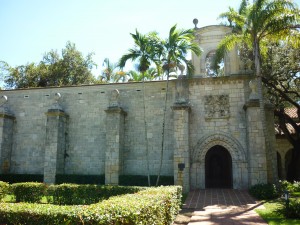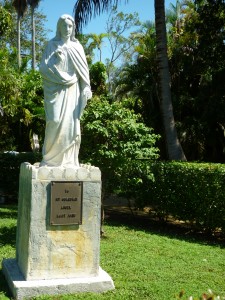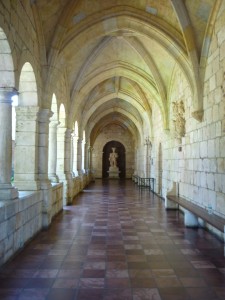Posted October 27, 2013
By RIANNA HIDALGO
NORTH MIAMI BEACH, Fla. — The 11,000 wooden crates that gathered dust in a warehouse in New York from the mid 1920s to the early 1950s didn’t contain new car parts or department store furniture. They contained the pieces of a Spanish monastery from medieval times.
That monastery now sits in North Miami Beach, rebuilt as a tourist attraction and church that draws tens of thousands of visitors each year.

The ancient Spanish Monastery draws thousands each year for weddings, tours and events (Photo by Rianna Hidalgo).
“It’s a rare find,” said Mary Kelly, a visitor from Connecticut. “You don’t get to see a monastery that’s almost a thousand years old brought over brick-by-brick every day. If you are going to be in Miami, there are a lot of things to see, but this is unique.”
Becky Matkov, CEO of the Dade Heritage Trust, said the monastery is a true asset for Miami, both for its beauty and its history.
“What a lot of people realize when they visit is that there is so much more history in Miami than we might think when we look at all the new construction,” Matkov said. “Miami in particular gets so inundated with new everything. It’s such a great learning opportunity and the monastery has such an interesting history.”
Built between 1133 and 1141 in Northern Spain in honor of the Virgin Mary, it was later renamed after St. Bernard de Clairvaux and was home to Cistercian monks for hundreds of years. In the 1800s, it was seized and converted into a stable during a period of social unrest.
Newspaper tycoon William Randolph Hearst purchased the monastery in 1925 and intended to ship it to his Hearst Castle in California. A series of misfortunes foiled his plans — an outbreak of hoof-and-mouth in Spain led to the immediate quarantine of the crates upon arrival in New York and when Hearst’s financial luck ran out, he had to leave the monastery behind. The ancient stones, with all their history and heritage, then sat in a Brooklyn warehouse for more than 25 years.
Hearst’s empty pockets were good news for Floridians of the future. In 1952, Miami entrepreneurs William Edgemon and Raymond Moss bought the monastery and had it relocated to North Miami Beach. Today the monastery is owned and operated by the parish of St. Bernard de Clairvaux.
Unloading the boxes and rebuilding the monastery was no small feat. It took 23 men three months to open the boxes and construction was the 3D puzzler’s dream. The stones were taken out of the crates during the quarantine, but were put back out of order.
“It was an incredible ordeal to put it together,” Matkov said. “They didn’t know until they opened the boxes that all the pieces were mixed up and jumbled.”
Thanks to numbers inscribed in the stones and $1.5 million, the workers completed the monastery in 19 months.
Today, the monastery seems out of place in the bustle of the surrounding area — strip malls, fast food and pawn shops litter the streets nearby. But inside, it offers visitors tranquility and a glimpse into ancient Spain. The urban scape outside is easily forgotten.
“It’s such a tranquil setting,” said Matkov, who has visited the Monastery many times. “To have this oasis is really quite lovely.”
Christine Lauffer, who was visiting from Michigan with her husband, agreed. “It’s incredibly peaceful,” she said.
Visitors start by entering the Museum Gift Store, where they can peruse ancient furniture and learn about the monastery’s history with a series of photographs.
From there, visitors head into the gardens. From the white statues to the monarch butterflies fluttering from hedge to hedge, it truly sets the tone for the monastery, which is a short jaunt down a stone pathway.
Inside the cloisters, arched ceilings, stone walls, coats of arms and life-sized marble statues are a constant reminder that the monastery is from a different time and place.
“It was very quiet and very inspirational,” said Carson Lauffer, who read about the monastery in a Miami guidebook. “It made me wish I could be around that kind of building more.”
The beauty of the property attracts thousands of couples who choose the monastery as their wedding site. Carolina Del Vecchio has been a wedding coordinator at the monastery for 13 years, and said many of them come back to visit.
“To see people get married and come back five, 10, 30 years later with their children is beautiful,” she said. “I’ve learned to love this place because this is a magic place to work, to have weddings, to do anything.”
It isn’t just a popular venue for weddings — on a Thursday morning, a photography crew was on its way out just as a young girl preparing for her Quinceanera was on her way in, dress in hand.
“There’s a lot going on here,” said Mayten Battaile, the parish administrator. “It’s not just the museum, there are a lot of services and it’s also an active church.”
Battaile said between all the events last year, the monastery had roughly 50,000 visitors.
The church — the St. Bernard de Clairvaux Episcopal Church — has its services in the chapel within the monastery, which was the dining hall of the original structure. The bell that once called monks to meals still hangs above the door.
Although not all visitors come for spiritual or religious reasons, it’s hard to ignore the serenity that seems to fill every crack and stone throughout the cloisters.
For Carson Lauffer, just standing in the presence of something so old with so much history was powerful.
“Some people might not get a lot out of it, but if they come with a sense of stillness and a sense of quietness they will,” Lauffer said. “If you want to find something deeper and higher in life, this is a good place to start.”
If You Go
- The monastery is located at 16711 W. Dixie Highway in North Miami Beach.
- Tours are self-guided and available Saturdays 10 a.m. to 4 p.m. and Sundays 11 a.m. to 4 p.m., unless the monastery is closed for a special event. They recommend calling ahead.
- The cost is $8 for adults, $6 for teens ages 13 to 18 and $5 for youth ages 6 to 12 and seniors, students and military. It is free for children under 5.
- For more information, go to www.spanishmonastery.com or call 305-945-1462.


